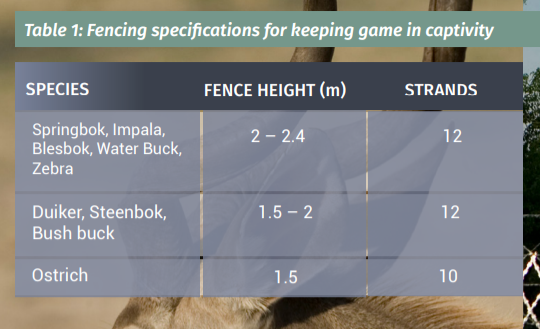Guidelines For Keeping Game Animals in Fields ( Masimo)
Main Photo: Thalefang Charles
The overarching objective of these Guidelines is to provide to aspiring citizens of Botswana an opportunity to have wildlife as part of production in their land. The specific objective of these Guidelines is to facilitate the keeping of wild animals or game in small agricultural land holdings.
Every citizen of Botswana (Individual, Companies, Trusts, Civil Societies, Churches or Interested groups) with registered land and has an intention to keep game animals on it shall be eligible to have game as part of their production in a field. Interested individuals will be expected to make an application to the Director of Wildlife and National Parks accompanied by a project proposal, documenting the intentions of the applicant. Game keeping will significantly contribute to sustainable utilization of wildlife, economic growth, creating employment to the local communities and changing their livelihoods.
Requirements
The following parameters must be covered in the project proposal
Land
Individuals wishing to rear wildlife in their field/masimo should demonstrate that they are legal occupants of the land. They should also provide proof that they have been granted permission to keep wildlife on their property. If the applicant has already submitted application for land to land authorities, proof of submission of such can be submitted along with application to rear game
N.B:
Assessment of the proposal will be carried out but the assessment of the piece of land will only be done upon allocation of the land by the relevant land authority.
The person should provide the following;
- Certified copy of National Identity
- Certified copy of proof of property ownership/lease/ title deed
- Letter of consent, if borrowed
- Size of the land
- Description and coverage of vegetation in the field
- Existing developments in the area if any (a sketch plan would do)
Start-up
To start up the project one will stock with the help of other existing farms/ranches, through;
- Donations by existing ranches and farms.
- Raffle prepared and produced by DWNP-(if a quota is available).
- Government and/or private institutions.
- Purchase from existing game ranches
Land Management
The applicant should indicate how the animals are going to be managed. Since the animals will be in an enclosure, game keepers must ensure adequate and reliable provision of fodder and water. Mixed stocking of different wildlife species will be allowed within the same space except for species known to interbred.
Wildlife species should not be mixed with domestic species. Click To Tweet
For maximum sustained yield to be achieved, there will be a comprehensive stocking and harvesting plan of excess stock to avoid or reduce inbreeding depression and prevent overstocking which may lead to soil erosion and a decline in range productivity of the farm.
A game keeper will attain this by stocking with species suitable for that geographical habitat range as well as by taking into consideration prevailing climatic conditions.
There must be a contingency plan to provide supplementary feeding for the animals when range conditions are unable to support the foraging requirements of the animals. Click To TweetSuitable supplements include Lucerne and hay from palatable grass species or commercial game feeds. All animals need to be adapted to game cubes/ pellets and self-mix feeds after a period of non-use (i.e. after the green season). Other types of feeds are not suitable for wildlife. Mineral supplementation in the form of palatable/mineral and salt licks should also be provided throughout the year.
It is not anticipated that large numbers of animals will be kept within the masimo setting but where there will be regular offtake, the numbers, ages and sexes of groups of introduced animals is crucial to the success or otherwise of establishing viable and therefore exploitable populations. When introducing a new “seed” population, the number and structure of the group influences the subsequent growth rate and therefore the level of income which can be generated.
The ratio of mature males to mature females can be manipulated through management. A greater proportion of females results in a higher lambing/calving percentage for the overall population. When the objective is to produce animals for live sales or for venison, the greatest proportion of females per male allowable for a species will yield the most profitable result. To maintain a sex ratio with a high proportion of females, a high number of male offspring must be removed annually from the population before they mature.
Ideally the majority of surplus animals should be harvested before or at the beginning of the dry season. This way, adequate food reserves are available to sustain the remaining animals through the dry months until the start of… Click To Tweet
Capture Methods
The game keeper can use both chemical and mechanical capture methods where feasible and /or economically viable. Where chemical methods are used, this must be done by duly trained and authorized personnel.
Training and Mentoring
DWNP will hold workshops to capacitate game keepers with basic game keeping skills. The game keepers will also be encouraged to enrol with Botswana University of Agriculture and Natural Resources for a comprehensive game ranching training course.
Reducing Excess Animals
The game keeper should inform the Director of DWNP by written communication his intention to harvest excess or old stock. Click To Tweet
The Director’s permit to hunt/cull/capture and/or sell game meat will then be issued following the request.
Fence Maintenance and Safety

It will be the responsibility of the game keeper to ensure that the fence receives routine and up-to-standard maintenance to prevent animals from escaping. A rapid and responsive effort must always be in place to recover loss of any stray animal and return it to the field, failure of which the Department will have the right to search for such an animal and dispose of it in a manner it deems appropriate without compensation to the owner. Regular and spot patrols should be undertaken to deter poaching.
Range Management
Firebreaks will be constructed and maintained around the perimeter fence of the field as well as within the confines of the field. Any controlled burning by the game keeper to stimulate vegetation growth will be subjected to permission approved by the Department of Forestry and Range Resources
Disease Management
Some of the diseases that affect wild animals and the game keeper must take cognizance of include anthrax, contagious abortion, foot and mouth, rinderpest, trypanosomiasis tuberculosis just to mention but a few.
Just like in cattle ranching, game keepers will be required to take precaution and be prepared to manage any disease outbreak.
Game keepers are advised to inform DWNP and the Department of Veterinary Services of any disease outbreak at the earliest time possible. Click To TweetThis will give responsible departments enough time to respond accordingly. Game keepers will be responsible to dispose of any carcass of a diseased animal in a clinically and hygienically acceptable manner.
DWNP reserves the right to monitor to ensure compliance to policy and control of diseases, especially where farmers keep livestock in around their masimo. DWNP will work with Department of Veterinary Services as the competent authority to ensure that proper protocols and procedures are put in place to monitor animal health and to intervene where necessary to prevent the spread of wildlife related diseases.
Marketing
Advertising is an essential component for the success of any business as it will help game keepers to be able to identify and attract customers and also build good relationship with them. Therefore, game keepers must be able to promote the selling of game meat and their by-products.
The project can be marketed on a small scale verbally or by social media, and interviews by either radio or television. Applicant should indicate the marketing methods they prefer.
Ecotourism
Where animals are being kept for tourism purposes, proper safety measures must be put in place including measures to keep tourists/visitors a safe distance from wild animals. Click To Tweet
Handling of animals by visitors must be avoided under all circumstances for animal welfare reasons and visitor safety. Animals should not be hand fed.
Employment and Security
An indication of number of manpower to be employed, to provide security, depending on the size of land. Recommended security personnel;
- Below 10 hectares 2
- 10-50 hectares 4
- 50-100 hectares 6
- Above 100 hectares 8
Assessment and Approval
After the applicant has submitted the proposal to the nearest DWNP offices, the proposal will be evaluated and if satisfactory, an approval letter will be sent to the applicant, setting a date for the assessment of the land. Click To Tweet
The assessment is carried out to ascertain whether developments as may be indicated in the project proposal do exist and as per requirements.



